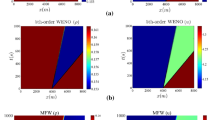Abstract
Congestion in Moroccan roads especially in urban areas is increasing and gaining in scale more and more nowadays, it can be induced by roads perforated, absence of traffic signs, behaviors of drivers, overcapacity of roads, illegal parking etc.
Also, disproportional traffic lights cycle in a junction also serves as cause of congestion. One of the most innovative solutions is to build an intelligent transportation system (ITS) to collect data in real time and adjust the cycle time of traffic lights in every road intersection, provide alternative paths and predict when and where congestion will occur. Having a numerical model that give reliable solutions in real time using accurate data is essential. In this perspective, we use the LWR macroscopic model to model traffic flow and we adapt numerical resolution methods of Lax-Friedrichs and Godunov Schemes to test their accuracy and adaptability for traffic situations.
Access this chapter
Tax calculation will be finalised at checkout
Purchases are for personal use only
Similar content being viewed by others
References
Strub, I.S., Bayen, A.M.: Weak formulation of boundary conditions for scalar conservation laws: an application to highway traffic modelling. Int. J. Robust Nonlin. Contr. IFAC‐Affiliat. J. 16(16), 733–748 (2006)
Nikolov, E.: Transfer function representation approach of the LWR macroscopic traffic flow model based on the Green function. In: Proceedings of the 9th WSEAS International Conference on Evolutionary Computing (EC 2008), Sofia, Bulgaria, May 2008 (2008)
Winckelmans, G.: Classification des équations aux dérivées partielles, méthode de caractéristiques pour les cas hyperboliques, Octobre 2007 (2007)
Şentürk, E., Coşkun, S.B., Atay, M.T.: Solution of jamming transition problem using adomian decomposition method. Eng. Comput. 35(5), 1950–1964 (2018)
Lighthill, M., Whitham, G.: On kinematic waves I. Flood movement in long rivers. In: Richards, P.I. (ed.) Proceedings of the Royal Society, London, Shock Waves on the Highway. Operations Research, May 1955, vol. 229A, pp. 281–316 (1956)
Richards, P.I.: Shock waves on the highways. Oper. Res. 4, 42–51 (1956)
Gerlough, D.L., Huber, M.J., National Research Council (U.S.): Traffic Flow Theory: A Monograph. Transportation Research Board, National Research Council, Washington (1975)
Guelfi, N., Mammar, A.: A formal framework to generate XPDL specifications from UML activity diagrams (2006)
Rascle, M.: An improved macroscopic model of traffic flow: derivation and links with the Lightill-Whitham model. Math. Comp. Model. 35(5–6), 581–590 (2002)
Lebacque, J.-P., Khoshyaran, M.M.: Modelling vehicular traffic flow on networks using macroscopic models. In: Proceedings of the FVCA II, pp. 551–558 (1999)
Zhang, Y., Chien, C., Iouannou, P.: Traffic density control for automated highway systems, Automatica 33(7), 1273–1285 (1997). PII: S0005-1098/97/00050-2
Chanut, S.: Modélisation dynamique macroscopique de l’écoulement d‟un trafic routier hétérogène poids lourds et véhicules légers, Thèse de doctorat INSA de Lyon, ENTPE/INRETS (2005)
Kachroo, P., Ozbay, K.: Solution to the user equilibrium dynamic traffic routing problem using feedback linearization. Transp. Res. B 32(5), 343–360 (1998). PII:S0191-2615(97)00031-3
Giorgi, F.: Prise en compte des transports en commun de surface dans la modélisation macroscopique de l’écoulement du trafic, Thèse de doctorat, INSA de Lyon, ENTPE/INRETS (2002)
Author information
Authors and Affiliations
Corresponding author
Editor information
Editors and Affiliations
Rights and permissions
Copyright information
© 2022 The Author(s), under exclusive license to Springer Nature Switzerland AG
About this paper
Cite this paper
El Ouenjli, H., Chafi, A., Alami, S.K. (2022). Numerical Resolution of the LWR Method for First Order Traffic Flow Model. In: Motahhir, S., Bossoufi, B. (eds) Digital Technologies and Applications. ICDTA 2022. Lecture Notes in Networks and Systems, vol 455. Springer, Cham. https://doi.org/10.1007/978-3-031-02447-4_75
Download citation
DOI: https://doi.org/10.1007/978-3-031-02447-4_75
Published:
Publisher Name: Springer, Cham
Print ISBN: 978-3-031-02446-7
Online ISBN: 978-3-031-02447-4
eBook Packages: Intelligent Technologies and RoboticsIntelligent Technologies and Robotics (R0)




